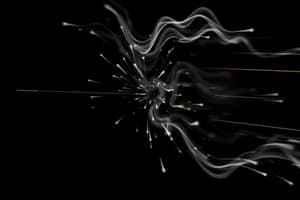Podcast
Questions and Answers
Which force is responsible for maintaining the motion of a pendulum in a swinging motion?
Which force is responsible for maintaining the motion of a pendulum in a swinging motion?
- Applied force
- Normal force
- Frictional force
- Tension force (correct)
When a baseball player catches a ball, which force is responsible for the change in the ball's velocity?
When a baseball player catches a ball, which force is responsible for the change in the ball's velocity?
- Frictional force
- Applied force (correct)
- Tension force
- Normal force
Which force acts perpendicular to the surface on which an object rests, opposing the force of gravity?
Which force acts perpendicular to the surface on which an object rests, opposing the force of gravity?
- Frictional force
- Applied force
- Normal force (correct)
- Tension force
Which force is responsible for the slowing down of a moving car on a flat road when the brakes are applied?
Which force is responsible for the slowing down of a moving car on a flat road when the brakes are applied?
According to Newton's third law, for every action force, there is an equal and opposite reaction force. Which force acts as the reaction force for the applied force?
According to Newton's third law, for every action force, there is an equal and opposite reaction force. Which force acts as the reaction force for the applied force?
In the context of frictional force, what does the magnitude of the frictional force depend on?
In the context of frictional force, what does the magnitude of the frictional force depend on?
Which of Newton's laws states that when an external force acts on an object, it produces an acceleration directly proportional to the force and inversely proportional to the mass of the object?
Which of Newton's laws states that when an external force acts on an object, it produces an acceleration directly proportional to the force and inversely proportional to the mass of the object?
What is the principle stated in Newton's Third Law of Motion?
What is the principle stated in Newton's Third Law of Motion?
Which factor is NOT involved in determining the magnitude of the frictional force?
Which factor is NOT involved in determining the magnitude of the frictional force?
According to Newton's Second Law of Motion, what happens to the acceleration of an object if the applied force remains constant but the mass of the object increases?
According to Newton's Second Law of Motion, what happens to the acceleration of an object if the applied force remains constant but the mass of the object increases?
Flashcards are hidden until you start studying
Study Notes
Force
Introduction
In physics, a force is a push or pull that acts upon an object due to the object's interactions with its surroundings. Forces have both magnitude and direction, making them vector quantities, represented by arrows with the size of the arrow reflecting the magnitude of the force and the direction of the arrow indicating the direction of the force.
Types of Forces
Tension Force
Tension force refers to the force that opposes motion between two connected objects. It is often described as the force exerted by one object on another when they are connected by a string, rope, or other material. In the context of elastic objects, such as springs, the tension force is proportional to the displacement of the spring's equilibrium position.
Applied Force
Applied force is the force exerted on an object by an external source. This force can change an object's motion, causing it to accelerate or change direction.
Normal Force
The normal force is the force that opposes gravity and pushes objects away from each other. It is sometimes called the force of air resistance. The normal force acts perpendicular to the surface on which an object rests and is equal in magnitude to the weight of the object. When an object is at rest, the normal force is balanced by the force of gravity.
Frictional Force
Frictional force is the force that opposes motion between two surfaces in contact. It is caused by the interactions between the microscopic particles of the surfaces. The magnitude of the frictional force is proportional to the force applied and the coefficient of friction between the surfaces.
Newton's Laws of Motion
Newton's laws of motion describe the relationship between force, mass, and acceleration. These laws are as follows:
-
First Law of Motion: An object at rest or moving at a constant velocity will remain in that state unless acted upon by a net force.
-
Second Law of Motion: When an external force acts on an object, it produces an acceleration that is directly proportional to the force and inversely proportional to the mass of the object. This can be mathematically represented as F = ma, where F is the force, m is the mass, and a is the acceleration.
-
Third Law of Motion: When one body exerts a force on another body, the second body exerts an equal and opposite force on the first body. This is known as the principle of action and reaction.
Conclusion
Understanding the concept of force is crucial in physics, as it helps explain how objects interact and change motion. By understanding the different types of forces and the principles outlined in Newton's laws of motion, we can better comprehend the natural world around us.
Studying That Suits You
Use AI to generate personalized quizzes and flashcards to suit your learning preferences.




